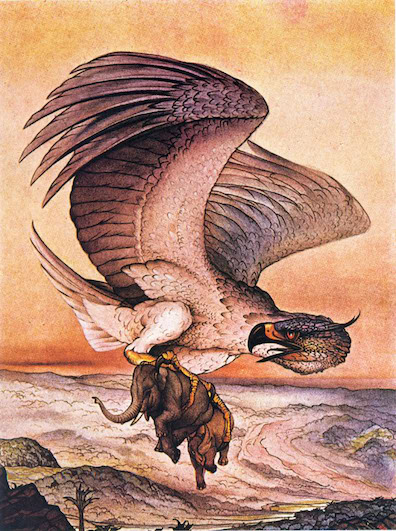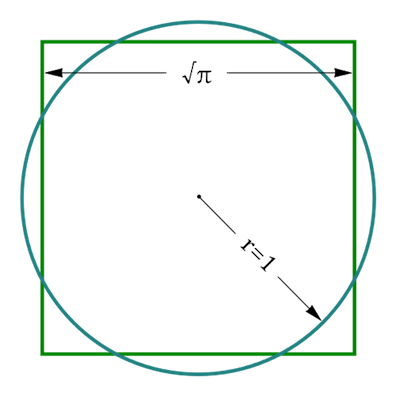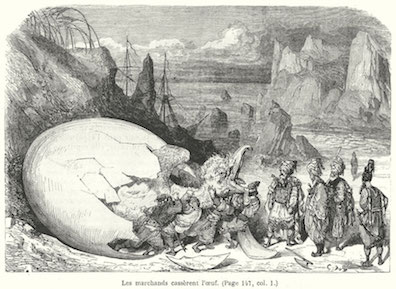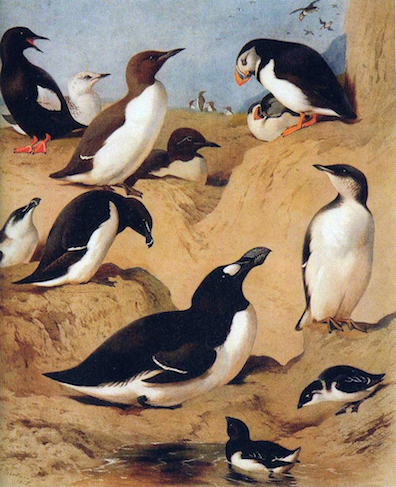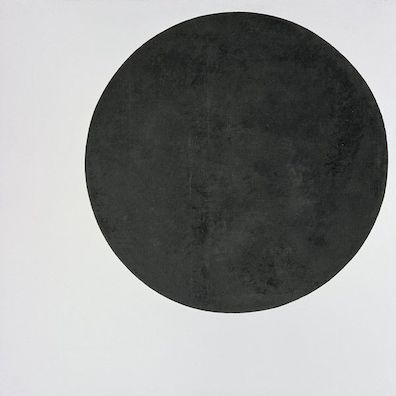Bloom is an Odysseus who has returned home to his Ithaca, and
at the end of his day the narrative says, "He rests. He has
travelled." It then poses a question: "With?" The
answer is Sinbad (or Sindbad), an 8th or 9th century Arabian
hero whose seven voyages unquestionably owe much to those of
Homer's hero. (The Odyssey was translated into Arabic
by the 8th century, and the story of Polyphemos is retold in
Sinbad's third voyage.) Sinbad thus joins Rip Van
Winkle, Enoch Arden, the Wandering Jew, and a small
host of fellow travelers who function as additional symbolic
analogues for Bloom's Odyssean mental adventures.
In Surface and Symbol, Robert Martin Adams observes
that along with "Sinbad the Sailor," "Tinbad"
and "Whinbad" were characters in the Sinbad pantomime
performed in Dublin in 1892 and 1893 (80). These names have
evidently prompted Bloom to transpose Sinbad's story into his
beloved register of nursery
rhyme, where silly verbal resemblances can drive a story
forward and people can become fancifully identified with their
occupations (Tinbad the Tailor, Jinbad the Jailer, Whinbad the
Whaler, Ninbad the Nailer, Binbad the Bailer, Pinbad the
Pailer, Minbad the Mailer, Hinbad the Hailer, Rinbad the
Railer). It is perhaps not too great a stretch to hear in
these phrases all the occupations that Bloom has encountered
people practicing in the course of his day, or remembered
himself practicing in earlier years, or imagined himself
practicing in a different life. (In Circe Bloom's
adventures of June 16 are cast as a similar-sounding series of
hagiographic attributes: "Kidney of Bloom, pray for us. /
Flower of the bath, pray for us. / Mentor of Menton, pray for
us. / Canvasser for the Freeman, pray for us....") As a kind
of Odysseus who has completed his long and eventful day's
journey and come at last to rest in his Ithacan bed, Bloom
sinks down into sleep "With" the similar figure of Sinbad,
spouting silly nursery rhymes all the way.
In the following paragraph, by asking itself the correlative
question "When?," the narrative continues the journey
motif by locating Bloom on a temporal slide into
unconsciousness: "Going to dark bed there was a square
round Sinbad the Sailor roc's auk's egg in the night of the
bed of all the auks of the rocs of Darkinbad the
Brightdayler." This sentence does not exactly answer the
question, but in a striking feat of mimetic representation the
bed into which Bloom is sinking becomes the site of a
bewildering host of associations, as if his mind is speeding
up rather than slowing down. The bed is dark, anticipating the
black extinction of consciousness expressed in the large black
dot at the end of the chapter. And the egg is "square round,"
a paradoxical figure that evokes the mathematical challenge
referred to earlier in Ithaca as "the quadrature of the
circle."
Why should Bloom be thinking such a thought at this moment?
Gifford hears an allusion to the end of Dante's Paradiso,
where the idea of squaring the circle conveys the pilgrim's
inability to rationally fathom the mystery of the
Incarnation—a failure that immediately precedes his mystical
vision of God. Although other annotators (including the
normally very thorough Slote) decline to second Gifford's
suggestion, it makes excellent sense given the temporal
context of Bloom "Going to dark bed" and approaching the
extinction of consciousness. Dante uses the famous
mathematical challenge to characterize his last moment of
ordinary human consciousness before he experiences the flash
of mystical enlightenment. Staring into the divine abyss, he
describes his struggle to understand its mysterious union with
humanity in the person of Christ:
Like the geometer who fully applies himself
to square the circle and, for all his thought,
cannot discover the principle he lacks,
such was I at that strange new sight.
I tried to see how the image fit the circle
and how it found its where in it.
(33.133-37)
Dante writes that he struggled to comprehend the mystery of
the incarnate godhead (the circle's constitutive principle of
π has now been shown to be just such a transcendental entity)
and that he would have failed "had not my mind been struck by
a bolt / of lightning that granted what I asked" (141-42).
After his mind's fruitless efforts at logical comprehension, a
mystical vision sweeps him up into the Love moving the sun and
the other stars and concludes the epic poem. If this allusion
lurks within Bloom's phrase "square round," it serves to
characterize Bloom's coming entry into the realm of sleep and
dream, which waking intelligence cannot comprehend. And here
Joyce's text alludes a second time to the Paradiso, in
a detail which Gifford did not notice but which provides
powerful confirmation of his hypothesis. Trying to fathom how
the image of mankind inheres in the divine circles above him,
Dante's pilgrim asks "come vi s'indova"—literally,
in a kind of neologism that Dante employs throughout the
Paradiso, "how it in-whered itself in it." Ithaca ends with
the question, "Where?" The answer is the large black
dot of incipient sleep.
The
square round roc's auk's egg carries still more
associations.
In the Sinbad stories, the roc is an enormous raptor, powerful
enough to carry elephants and huge snakes to its nest to feed
its young. In his second voyage Sinbad hitches a ride on a roc
to the valley of diamonds,
and then he tricks one into carrying him back to its nest. On
another voyage, the fifth, his crew spots an immense roc's
egg, breaks it open, and eats the chick, bringing
destruction down upon themselves from the avian parents much
as Homer's men do when they kill the cattle of the sun god.
Joyce may still be injecting echoes of the Commedia
into Bloom's thoughts here: Dante's pilgrim gets his first
taste of mystical rapture in canto 9 of Purgatorio
when, in a dream, an eagle carries him Ganymede-like into the
sphere of fire, filling him with terror. But the roc also has
powerful associations with Sinbad's great topic, the
acquisition of wealth. (He tells his tales to a poor man, also
named Sinbad, who wants to know why some people enjoy great
riches while others must endure poverty.) Getting to the
valley of diamonds by roc, and thence to a roc's nest, has
enriched the hero with a trove of gems.
Bloom's preoccupation with accumulating wealth ensures not
only that this part of the Sinbad story would appeal to him,
but also that he would think of it at bedtime. Earlier in
Ithaca, he has contemplated various fantastic schemes for
getting rich, one of them involving finding "an antique
dynastical ring" that has been "dropped by an eagle in
flight." The narrative asks why Bloom should spend time
dreaming up such outlandish ideas, and answers that he has
learned from experience that happily fantasizing about wealth
before going to bed helps him to sleep well. At the end of the
chapter, then, as he drifts off to sleep, the pantomime's
story of a raptor associated with great wealth predictably
enters his thoughts. Given Joyce's incredible capacity for
layering multiple associations on top of one another within a
small detail, it seems possible that he added his own thoughts
of an eagle carrying a dreamer up to heaven with his
protagonist's thoughts of an eagle dropping wealth into his
lap.
All of these speculations about Bloom's thought processes in
his last moments of consciousness are inferential, and the
chains of association become more tenuous as the final
sentence of Ithaca reels toward the final incoherence
of the black dot. Why does the roc become an "auk," a
group of diving Atlantic sea-birds in the alcid family?
Certainly not because of size: even the extinct (ca. 1852)
great auk stood no higher than about 3 feet (1 meter). The
link is probably purely linguistic, one "oc" sound childishly
engendering another as in the nursery-rhyme variations on
Sinbad's name.
As
for "Darkinbad
the Brightdayler," this
is a hill that few of Joyce's annotators or commentators
have been willing to die on. Thornton, Gifford, Johnson,
Kiberd, and Slote all pass over it in dumb silence, and it
does not seem to have received very much attention in the
critical literature either. Adams supposes, not very
helplfully, there may be a "subtle reference to Max
Müller's theory that Odysseus was originally a sun-god" (Surface and Symbol, 81). It
seems to me more likely that Joyce here is continuing his
series of alliterative Sinbad the Sailor names. Sinbad
becomes Darkinbad because he has gone into a dark bed, and
Sailor perhaps becomes Brightdayler because this place of
dark night opens, on the other side of unconsciousness,
onto the bright daylight of dreams. Probably other
meanings can be detected in the two words. As in
experiences of Finnegans Wake, Joyce
points his readers toward some well-defined ambiguities
and encourages them to add their own.
To
his credit, Adams observes that at some point all efforts
of critical interpretation should be abandoned
because "the going-to-bed litany is a piece of inspired
stupidity, like Charles Bovary's famous hat, containing layer
after layer of meaninglessness—an unfathomable depth of mental
void. Relaxing its hold on external reality, and on its own
thought processes, the mind is shown drifting off into a
mechanical word-cuddling, and so into complete darkness. The
more we project conscious intellectual meaning into the
process, the less it serves its overt purpose. Like a
Rorschach-blot, the passage will absorb anything we want to
put into it, but there is a point at which our insertions, by
expressing 'us' all too richly, frustrate the ends of the
novel" (82).
This caveat serves a valuable purpose. Bloom's muddy
half-thoughts are certainly more than a little stupid, as are
those of every human being drifting off to sleep. But readers
can also benefit from the hindsight of knowing something of
the book that Joyce wrote next. Finnegans Wake, the
ultimate Rorschach blot, suggests that in sleep thousands of
suggestive threads of meaning become tied together in patterns
that do not respect the laws of daylight logic but are easily
as complex as waking thoughts. The
accelerating flood of half-coherent ideations represented
at the end of Ithaca evokes
this daily human passage from the crowded reality of
daytime thoughts to the less comprehensible but still more
crowded experience of dreams. Could Joyce already have
been thinking of his book of Darkinbad as he finished his
book of Bright Day? A note full of credulity-straining
suppositions will conclude with one more: amid the list of
Sinbad's alliterative cousins is one, "Finbad the Failer," whose
name richly evokes the next defeated conqueror on Joyce's
horizon.

